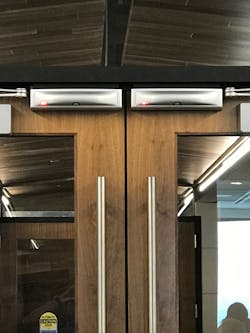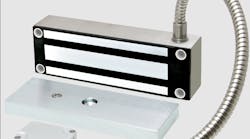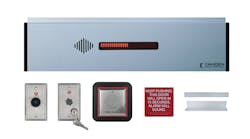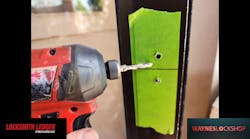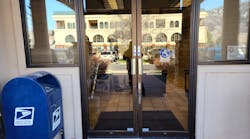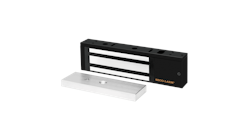When, where and how should you use an electromagnetic lock, or maglock?
Maglocks go way back — think the ’60s, baby! — showing their staying power as an effective part of perimeter entrance control and a critical component to layered security at a protected premises. These security stalwarts remain quite relevant today, with many different possible applications and form factors, including the latest intelligent, eco-friendly devices and products that reduce touch points, contributing to a healthier workplace environment.
Maglocks are the ideal entrance security device for many locations and projects. Numerous features and functionalities make them suited to a wide range of openings and entrance configurations. Maglocks fit with more-traditional architecture as well as the latest glitz-and-glam glass openings that are trending in corporate and retail settings.
Maglock advantages include a lack of moving parts that might fail or be tampered with, as well as the fact that they can be surface- or flush-mounted and will lock swinging, sliding and double glass doors. Maglocks come in different sizes and mounting configurations not only for standard doors, but also for cabinets, gates and even barn-door-style sliders. Maglocks have fast release times, which make them suited to high-traffic applications in hotels, commercial lobbies, exterior fencing and gates for vehicle traffic and other properties.
Fantastic Four
In a basic configuration, the electromagnetic part of the lock is attached to the door frame and a heavy steel plate called the armature is attached to the door. The two components are in contact when the door is closed. When the electromagnet is energized, a magnetic current to the components is generated, thus creating a strong holding bond.
Operationally, if the current were turned off, the door would release. When the power is on, the door is secure. Maglocks are fail-safe, so when power is lost, the lock will release, and occupants can egress safely. When used as part of an access control system on a path of egress, maglocks released by a sensor (Request to Exit, or REX) require a connection to disengage automatically when fire alarms or sprinkler systems activate, which then provides free access. This configuration also requires a push-button within 5 feet of the opening that has a fixed timer set for 30 seconds when activated as a backup to the sensor.
Maglocks also might be used to secure the door in tandem with push-to-exit bars, which can be configured with built-in switches to break power to the lock. Understanding the codes and policies adopted by the local Authority Having Jurisdiction (AHJ) is important when determining which method is best for releasing a maglock installed on an opening.
Maglocks fit a variety of markets, including retail, hospitality, healthcare, corporate, high security, institutional or correctional and campuses. There are many variables, and it’s important for the device to adhere to building, fire and life-safety codes, which include the International Building Code, International Fire Code and NFPA Life Safety Code 101. Of course, the AHJ, based on the year or version of the code that has been adopted locally, will dictate the specifics for safe egress and compliance with regards to their proper use.
Here are four ideal places to consider using maglocks:
1. High-traffic openings
Maglocks provide high durability and low maintenance, which makes them suitable for areas that have higher opening rates throughout the day because of traffic levels. Because Maglocks have no moving parts, a fluid and frequent visitor population should pose no problem with regard to wear and tear. Latches and strikes, however, contain many moving parts, which wear over time and can increase the potential for mechanical failure.
You always should refer to the maglock product specifications and consider the activity level of an opening. How many people daily will use it — 100, 200 or more? What’s the opening level per day — 500, 1,000 or 5,000 times? Those considerations have to be calculated.
2. Sliding applications
Vast expanses of glass let light in and architecturally create vast open spaces. As design trends increase the demand for sliding doors, including single and double doors, maglocks are becoming increasingly popular for these areas.
So-called shear, or concealed, maglocks, work well on sliding or swing doors in light- to medium-security applications, such as private workspaces or atriums. Many latches and strikes don’t provide sliding functionality for access control, so shear maglocks can fill the gap.
When the opening is closed, it brings the maglock and strike plate together, securing the opening while retaining the aesthetics of the building’s architecture.
3. Perimeters and gates
A maglock’s superior outdoor ratings stand up to the elements while their holding force and fully sealed electronics repel even the harshest weather and environments. By using various mounting solutions, maglocks are a great way to provide access control to high-level and mid-level security areas, such as swimming pool gates, apartment complexes, gated communities, multitenant buildings and storage compounds.
4. Difficult installations
Many openings can be difficult and expensive to introduce a lockset or a strike, particularly all-glass and sliding applications where there isn't room for a strike because of abbreviated spaces or because of aesthetic concerns. A maglock is a great choice in such situations because of the various mounting brackets available that can accommodate in-swing and out-swing doors while facilitating simpler installation.
Plus, coring a door and providing power transfer for electrified hardware can be time-consuming, difficult and sometimes impossible, depending on the property or structure. Maglocks are available with a variety of optional accessories, including installation kits, dress covers and housings to streamline installation for different applications.
Other Roles
For double doors that don’t have a center mullion, double maglocks create aesthetically pleasing design possibilities. Direct-mount maglocks are recommended for applications where physical assault on the door isn’t expected, such as controlled interior rooms and secure areas of a building. Heavy-duty maglocks that have 1,200–1,800 pounds of holding force are preferred by prisons and detention facilities and recommended for exterior and perimeter doors and high-security gates.
Maglocks also play a role in the configuration of delayed-egress and controlled-egress systems. A maglock can be a part of a component-designed system or in a stand-alone configuration in which the electronics for creating the delayed egress is built as part of the maglock. Delayed-egress systems allow passage after a specified period – 15 or 30 seconds, depending on the time allowed on the delayed-egress-system permit approved by the AHJ. Delayed-egress control also might be configured in conjunction with access control systems.
Finally, it’s possible to reduce touch points, critical in today’s contagion-prone environment, with some of the maglock configurations and integrations available. No-touch exit switches, wireless transmitters and exit motion sensors often can be incorporated into maglock projects along with a door operator.
However, not all applications are appropriate for maglocks. One application in particular has caused maglocks to get a bad rap. This takes us back to the initial discussion about fail-safe versus fail-secure openings.
Their fail-safe operation means that maglocks unlock when power is removed, dropped or lost, remaining open for unsecured egress or ingress and fire-safety considerations. Codes direct that maglocks, based on the installation configuration, might be required to connect to the fire-alarm system. If connected to the fire-alarm system, the maglock must unlock automatically upon loss of power or activation of the fire alarm or sprinkler system.
So, maglocks shouldn’t be used where fail-secure access is required, such as high-security applications, because in a power failure, access to whatever is being protected will be open. Fail-secure locking solutions should be used on doors where entry security is a concern, because they will remain locked during a power outage.
Understanding product use and application is important to specify maglocks properly and typically is identified during the Site Survey and conversation with the customer. Knowing the applicable codes and standards and the AHJ’s requirements are the places to start, as well as determining the security level (high, medium) and traffic control or flow desired. Other considerations include: door application (in-swing, out-swing, sliding); holding force; current draw or voltage; and compliance requirements, such as fire ratings or UL listing (ANSI/UL 294, Standard for Access Control System Units).
Rodger Schmidt, CAI, AFDI, is an ASSA ABLOY technical product trainer. He provides continuing education, technical training, webinars and other instruction to the electronic security hardware, door access and locking solutions industries. He can be reached at [email protected].
